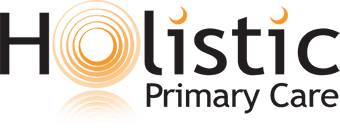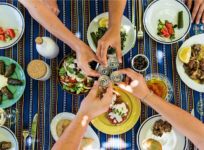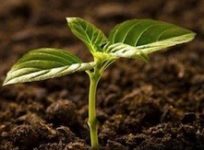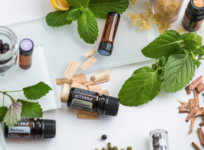 |
|
| Sgt. Brandy Rose Lipscomb, a field medic with the Washington National Guard, and a 4th year naturopathic medical student at Bastyr University, uses craniosacral techniques to treat a soldier at LSA Anaconda, a US military base in the region of Fallujah, Iraq. Courtesy of Sgt. Brandy Rose Lipscomb. |
From a military field hospital in Iraq to refugee relief centers in New Orleans and Sri Lanka, holistic physicians are demonstrating that natural medicine can play a vital role in crisis response and critical care.
All too often, holistic health care is viewed as a humanistic side dish to conventional medicine’s main course of drugs and surgery, or as “boutique” health care for well-off people. But practitioners volunteering in disaster zones are boldly showing what holistic medicine can bring to front-line trauma care.
“Is there a role for natural medicine in disaster relief work? Absolutely, yes!” emphasized Eric Udell, ND, a naturopath from Arizona who recently returned from Sri Lanka, where he served villages devastated by last year’s tsunami. “I often hear that what we do is preventive medicine. It is much more than that. We can and do treat acute infectious diseases and trauma. Our medicine has a much bigger role to play.”
According to Henri Roca III, MD, assistant professor of medicine at Louisiana State University, New Orleans, and chief of LSU’s Integrative Medicine program, the holistic approach, “is really the only way to work with people surviving disaster.” For the past two months, Dr. Roca has been providing Katrina survivors with comprehensive holistic services, including acupuncture, guided imagery, biofeedback, massage, hypnotherapy, botanical medicine, and nutritional counseling.
“You can presume almost everyone in southern Louisiana and Mississippi is experiencing some form of post-traumatic stress disorder. I’d say that 60% of my medical students are showing definable signs. And all the pills in the world won’t solve PTSD. You simply have to take a holistic approach,” said Dr. Roca.
What follows are snapshots of holism in action, portraits of healers on the front lines providing compassionate holistic medicine in dire circumstances. May they be both an inspiration and an example.
Brandy Rose Lipscomb: The “Shaman Medic”
In the fall of 2003, Brandy Rose Lipscomb was starting her 4th year of naturopathic medical school at Bastyr University, when she got word her National Guard unit was shipping out to Iraq.
So began an odyssey that took the young West Virginia woman from the lively classrooms and peaceful meditation gardens of one of the nation’s flagship naturopathic schools to an airbase near Fallujah, where mortar fire, VBIDs (vehicle-borne improvised devices, aka car bombs), and ghastly battlefield trauma were a daily reality. During her 18 months as a combat medic, Sgt. Lipscomb learned just how well the principles of natural medicine hold up under fire. She also learned that compassion and healing intent transcend and transform even the most brutal conditions.
Her first assignment was in the physical therapy unit at the Troop Medical Center at LSA Anaconda, a massive base 2 hours from Fallujah.
“We were treating 30 or 40 wounded soldiers and marines every day—guys who’d been thrown from trucks by bombs, injured ankles and backs. I did a lot of massage, structural adjustments, postural assessments, and physical exercises to strengthen and stretch. We helped them avoid surgery, and basically kept those boots on the ground. I was also able to facilitate healing on spiritual and emotional levels through counseling and energy work,” she said in an interview with Holistic Primary Care.
Battlefield medicine and holistic health care do not usually go together in most people’s minds, but Sgt. Lipscomb found she could bring many holistic techniques, from homeopathy to craniosacral to guided imagery, to the base. Some of the men she treated had been exposed to loads of environmental toxins from trash dumps or the fires that inevitably follow heavy combat. “We were able to do detoxification protocols to help them clear the toxins.”
Sgt. Lipscomb found homeopathy an invaluable healing ally. “It really is an amazing modality. I treated soldiers with spider bites, chemical burns, mortar wounds. It is highly effective. I think homeopathy should be a basic part of American health care.”
While at LSA Anaconda, Sgt. Lipscomb found herself aligning with the original Latin root of the word, “Doctor,” which is docere, to teach. “I was able to teach patients and cohorts how to choose better foods by their blood type and principles of Ayurvedic medicine. I taught them how to choose foods that would give them real energy, not just sugar rushes.” No easy task, given the military’s food options. Uncle Sam’s fare “tended to fit the description of SAD, the standard American diet,” heavy on meat, fat and sugar, thin on vegetables.
Given her naturopathic orientation, Sgt. Lipscomb stood out among her conventionally trained colleagues. Some soldiers on the base affectionately nicknamed her “the Shaman Medic.” In general, she found Anaconda’s personnel very open to holistic medicine. “They used me as their natural health guru.”
She found support from a superior officer, Col. Mimi Fields, a holistic MD from Olympia, Wa., who is an advocate of homeopathy and other natural therapies. “She was elated when she discovered I’d received a shipment of homeopathic medicines, and she’d sign off on my administering them to the patients.”
It was when she was re-assigned to a facility known as “Area 51,” that Sgt. Lipscomb discovered the true nature of compassion. Area 51 was the holding unit and hospital for wounded Iraqi people, including many insurgents.
The patients at Area 51 were badly damaged, many with gunshot wounds or traumatic amputations caused by bombs. “Some of them were really nice, but some of them wanted to kill us,” she said. Working with her weapon close at hand, and armed guards nearby, she faced the profound challenge of shifting mindsets from warrior to healer.
“It was hard to go from seeing all those injured marines—my boys—going home all messed up or in coffins, and then taking care of people who might have caused those injuries.” The bare truth, though, was that here were people in desperate need. They called forth a level of caring Sgt. Lipscomb had never before experienced. In an email she sent back to Bastyr, she described a particularly profound encounter:
“I keep a very crude English/Arabic interpretation book with me at all times, and when we have a free moment I like to pull it out and teach English to the patients and learn Arabic from them. We have gotten into some pretty interesting conversations this way. One patient asked me why I was so kind to him and I had to get out the book to explain my philosophy on life. I managed to say in Arabic, ‘One Earth, one God, one People. Love for All. Peace for All. You are not my enemy. Fear and hatred are my enemies.’ I later found out that the MPs who captured him found videos and pamphlets on ‘How to Kill Americans’ in his car.”
For the most part, the patients in Area 51 were simple people caught in a bad situation, and they were grateful for the care they received from the redheaded American medic. “Many of these men have a great sense of humor and most of them are so grateful for a little bit of laughter in their day. I have been offered a lot of dinar and 500 sheep by one of my patients if I will be his second wife! I have been asked to go to Mecca with another,” she wrote back from Iraq.
When the going got really tough, she called on the vision of a woman who she believes is the embodiment of grace under duress: Mother Teresa. “She’s a model to me because here was a woman who regularly bathed and fed people with contagious diseases, yet she did so without fear, and through the grace of God, she never got sick herself. I felt that by reaching out to her, I could channel that same kind of grace,” she said in an interview with Bastyr Magazine.
Though she did not experience direct attacks while at Anaconda, mortar fire was a common phenomenon. The constant stress frayed her nerves. “PTSD? You bet!” Sgt. Lipscomb admitted. “It has been much harder to re-adjust than I thought it would be. I’m walking around (Bastyr) campus and I’m constantly wondering, ‘Where’s my weapon?’ A car backfires, and my heart starts racing. It has taken me a while to realize I don’t have to clear my weapon before entering the dining hall. It is doubly hard because few here can relate to what I’ve been through.”
Bikram yoga, the University’s counseling program, and the love of family and friends have helped, but the transition is still difficult. “It’s been six months, and I still wonder when I’m going to feel OK. I’m glad I served my country. But a piece of my innocence is lost. My sense of security is gone forever.”
On the positive side, Sgt. Lipscomb joked that compared with Iraq, medical school is easy. “There’s nothing they can throw at me now that will stress me out.” And she’s learned to appreciate simple things. “Any day that passes in peace is a gift.”
Sgt. Lipscomb, who is still on active duty with the National Guard, said that while Iraq was extremely difficult, she has few regrets. “Although we are only making small differences on a grand scale, we sometimes make grand differences on a small scale, and these are the triumphs that we will remember with pride and a sense of accomplishment.”
Once she completes her naturopathic training, Sgt. Lipscomb plans to write a book about her experiences in Iraq, with an emphasis on the role natural medicine can play in the military. She is also considering the idea of founding a non-profit organization to bring comprehensive natural medicine to regions wracked by disaster and war.
New Orleans in the Wake of the Flood
“One of the key things about the aftermath of Katrina is that we have an entire population suddenly thrown into ‘the flow.’ All their mental maps of their lives, their sense of self and place, have been shattered. For many, the whole idea of planning for the future has been completely erased. I don’t think we’ve ever had so large a population in the US face displacement like this since, perhaps, the Civil War,” said Dr. Henri Roca, III.
Dr. Roca, whose ancestors had been in New Orleans since the 1700s, left the city the day before Katrina hit, but returned a week later to what he called, “A tale of two cities. The pre-1840s areas, built on higher ground, were more or less intact. The lower areas were destroyed.” In general, the high ground neighborhoods are primarily White and well off; the lowland areas are poor and primarily Black.
Dr. Roca immediately joined colleagues at LSU in essentially constructing a full-spectrum hospital on the fly. “They were evacuating thousands of people to the LSU field house, including nursing home patients, residents of special needs homes, and other medically-vulnerable people. In the first two weeks after the storm, the small group I was working with saw 7,000 patients.”
While other physicians addressed patients’ physical trauma and immediate needs, Dr. Roca used acupuncture, eye movement desensitization techniques, the emotional freedom technique (trigger point tapping), guided imagery and massage to heal the psycho-spiritual trauma, which can have detrimental health effects long after physical injuries heal.
“Trauma, especially repeated trauma, literally changes how the brain works. It changes the structure of the amygdala, prefrontal cortex, and hippocampus so you’re preferentially keyed up for the stress hormone cascade. It also affects Broca’s area, responsible for language processing, so you can’t really work through it with talk therapy alone. You need techniques like EMSR and guided imagery that tap into non-verbal parts of the brain.”
Dr. Roca said he is not alone in bringing holistic practices to the flooded city. “We’ve had a tremendous outpouring of help from holistic physicians, massage therapists, nurses, acupuncturists, Reiki practitioners, and others.” The city’s medical establishment has been largely supportive, though most of the holistic care occurs under the radar of “official” relief agencies.
As LSU physicians swung into action at the field house, a coalition of community activists called Common Ground, scrambled to establish what soon became a major locus of holistic disaster relief. The Common Ground Clinic began as a first aid station manned by 3 non-physician “street medics” at the Masjid Bilal, a small Black Muslim mosque in Algiers, just across the River from the French Quarter.
Word of the project spread across the country at fiber optic speed, and within days—thanks in part to Louisiana’s emergency credentialing policy for out-of-state medical personnel—dozens of volunteer physicians, nurses, and diverse health practitioners decamped around the Masjid. The makeshift first-aid station quickly bloomed into a self-organizing, full-service, walk-in primary care clinic, with satellite stations in churches and community centers throughout New Orleans. The Public Health Service recently recognized Common Ground as the most successful community clinic to emerge in New Orleans following Katrina.
“Common Ground is a holistic, fully-integrative free clinic providing botanical medicine, homeopathy, massage, acupuncture, and all sorts of stuff in a poor, Black, medically-underserved population. It runs solely on donations and volunteer effort,” said Dr. Roca, a medical advisor to Common Ground. “The wonderful thing is that it is in a place that was already consecrated as a sacred space, and it can serve people where they live.”
Common Ground is still in need of medical supplies, nutritional supplements, and personal hygiene products, as well as volunteer doctors, nurses, pharmacists, medical students and others. Dr. Roca said the collective is desperately trying to raise funds to establish a permanent sustainable clinic in Algiers. “They really need support or the whole thing will disappear.” (If you are interested in volunteering, providing supplies or other support, visit www.commongroundrelief.org.)
Grassroots efforts have been integral in providing relief in New Orleans, said Dr. Roca. Volunteers from Acupuncturists Without Borders (www.AcuWithoutBorders.org) have been steadily treating thousands of New Orleans’ citizens as well as the city’s police force and relief workers. The Wholistic Wellness Network (www.wholisticwellnessnetwork.org), a virtual community of holistic practitioners Dr. Roca helped organize, has been bringing teams of “Wholistic First Responders” to sites throughout Louisiana.
The major national organizations are starting to recognize the benefits that holistic practitioners can provide. Dr. Roca said Volunteers of America recently started a holistic therapist outreach program, and is hiring massage therapists, hypnotherapists and other mind-body practitioners to work in its shelters. Diane Fried, director of Acupuncturists Without Borders recently wrote from the field that her group aligned with the Red Cross to bring acupuncture to the ravaged streets of the Ninth Ward—no small feat, given the generally negative stance the larger agencies hold on “alternative” medicine.
With characteristic thoughtfulness, Dr. Roca reflected on the big picture of healing a badly wounded city. “The destruction of longstanding infrastructures and systems is followed by an immediate response that produces some amazingly creative new systems. But after a while—you can already see it—big agencies with vested interests come try to recreate systems that used to be in place, many of which were destructive to begin with. They create rules, and suddenly, if you want to play, you have to play by those rules.”
An American Naturopath in Sri Lanka
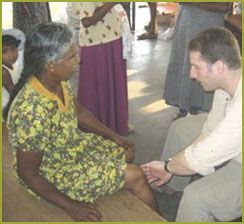 |
|
| Dr. Eric Udell examines a Sri Lankan woman who survived last year’s Tsunami. Courtesy of Dr. Udell. |
Within days of last December’s tsunami, Dr. Paul Mittman, dean of the Southwest College of Naturopathic Medicine, sought ways the ND community could pitch in. He met with a surprising amount of resistance. Larger relief agencies did not recognize NDs as fully-fledged medical practitioners and refused their service.
Eventually, Dr. Mittman found Homeopaths Without Borders (www.homeopathswithoutborders.net), an international aid group that welcomed the naturopathic help. Eric Udell, ND, who had studied homeopathy at Southwest as part of his training, was
soon heading for Sri Lanka. He arrived four weeks after the tidal wave, finding himself on a beautiful, but utterly ravaged island. “The tsunami destroyed nearly everything but the trees. There were mass graves with thousands of bodies everywhere.” The medical need was tremendous.
Dr. Udell and the HWB team decamped to a town called Peraliya, in the Southwest of Sri Lanka, where the wave had overturned a commuter train, killing more than 2,000. “People from all over the world were coming to Peraliya to help.” One of the few standing structures was the town’s school, which became the de facto relief center. Dr. Udell and his team quickly went to work.
He treated hundreds of people for everything from major tsunami-related trauma to psychological distress. “We ended up doing a lot of primary care. Sri Lankans were short on that to begin with.” Many had diabetes, reactive airway disease, and a panoply of nasty skin disorders, all of which were aggravated by intense heat, tropical humidity, and constant exposure to standing floodwater.
Dr. Udell said he was most surprised by what wasn’t present among the people he treated. “We expected a lot of cholera, typhoid and other infectious diseases, so we took along classical homeopathic remedies for these conditions. We did not see them,” he said in a presentation at the annual meeting of the American Association of Naturopathic Physicians.
Homeopathy was a big hit with Sri Lankans. Many preferred it to drug therapies. “We were told repeatedly that the ‘English Medicine’—that’s what they call allopathic drugs—’cooked our insides.’ These people had not been exposed to a lot of pharmaceuticals before and they were very sensitive, so there were a lot of drug side effects which turned them away from conventional medicine.”
The HWB team prescribed a lot of Arnica, the default homeopathic trauma remedy, but quickly found that not all trauma cases respond to Arnica. So, they also used a lot of Brionia, a lesser known homeopathic for trauma.
The experience of treating large numbers of people daily put a fine edge on Dr. Udell’s diagnostic skills. “We really had to key in on characteristic symptoms—the unique, striking symptoms peculiar to a given individual. It required a really thorough knowledge of the homeopathic Materia Medica“.
For festering diabetic ulcers, he found the combination of homeopathic Kali bichromium, 30C, four times daily, and poultices of fresh aloe to be highly effective. “The funny thing is, aloe is native to Sri Lanka, and people use it for all sorts of things, but never like this. We ended up using it all the time, and the ulcers really do heal up very well.”
The team treated reactive airway disease and chronic rhinitis with Kali carbonicum, Arsenicum album, Pulsatilla, or Medorrhinum, depending on symptom patterns. Serious skin disorders like gangrene, cellulitis and necrotizing ulcers were common, as was “Tsunami Itch,” an eruption-less itch resulting from long exposure to the tsunami water. Sulfur and Psorinum, classic remedies for skin diseases, usually worked to quell symptoms.
In addition to homeopathy, Dr. Udell used a lot of physical medicine techniques. “We made a makeshift examination/manipulation table out of plywood and cinderblocks.” These techniques were a completely new experience for Sri Lankans. “I learned important Sinhalese words, like ‘Breathe in’, ‘Breathe out,’ and ‘Relax.’ As they came to trust us, it became easier to do this kind of work.”
Throughout his time in Sri Lanka, Dr. Udell was constantly amazed by the warm-heartedness and generosity of the island’s citizens. “People who had lost everything were worried about whether we had eaten enough, or had enough water, or had fresh tea. The hospitality was astonishing, and the healing really went in both directions.”
